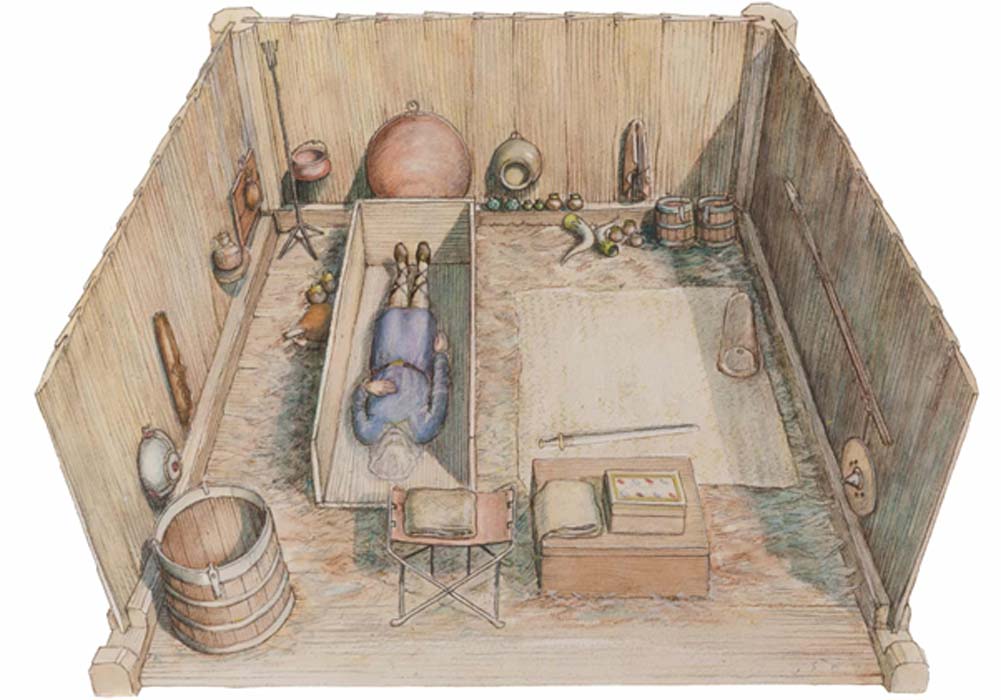Anglo-Saxon Burial in England Is Compared to King Tut's Tomb
Archaeologists are expected to reveal to the public what is now believed to be one of the most significant archaeological finds in England in recent decades. They will announce their findings of a magnificent royal burial, which has been compared to the grave of the famous Egyptian Pharaoh, Tutankhamun. It is expected to change how we view Anglo-Saxon England.
The burial was found during a project to extend a motorway and was discovered by construction workers on a patch of grass next to a congested road. It was not a promising place to find historic treasure, as it is near an ordinary pub and a busy supermarket. The discovery was made outside Prittlewell in Southend-on-Sea, Essex, in 2003.

The Prittlewell burial site was discovered in 2003. (MOLA)
The Prittlewell Burial is a Grave Worthy of a Pharaoh
The workers notified the relevant authorities, which is required by law. Archaeologists began to investigate the area, in order to prevent looting, and what they found was astounding. They unearthed a large burial chamber that was replete with many grave goods. The Guardian reports that Sophie Jackson, from the Museum of London Archaeology, as stating that “it could be seen as a British equivalent to Tutankhamun’s tomb, although different in a number of ways.”
The chamber was investigated for over 15 years, by a team of 40 experts and researchers and their amazing conclusions are now being revealed for the first time.
The burial chamber, “which would have measured about 13 feet (4 meters) square and 5 feet (1.5 meters) deep,” according to the BBC, held a variety of many precious artifacts. Archaeologists retrieved some forty artifacts from the Anglo-Saxon world and beyond. Among the items that were recovered was an intact lyre, a musical instrument, which is decorated with semi-precious stones that came possibly from India.

At the Prittlewell burial the remains of a lyre with decorative copper-ally fitting with garnets in the center. (MOLA)
There was also found a complete painted wooden box, the first of its kind ever found from the Anglo-Saxon world. The hoard included coins, drinking horns, and wooden vessels and a golden buckle was also unearthed. The BBC reports that “a flagon believed to have come from Syria” was also among the grave goods. Such riches in the chamber led to the comparisons with the Tomb of Tutankhamun.

Objects found at the Prittlewell burial site include a gold belt buckle, a copper alloy flagon from the Mediterranean, a decorative hanging bowl, and gold coins. (MOLA)
Because of the nature of the soil, all the carbon-based material has long-ago disintegrated and the burial site was only a sandy pit when it was revealed to the light for the first time. The remains of the person interred there had also disappeared. Only some teeth remained but they had precious DNA.
Carbon-dating revealed that the burial was from “between 575 AD and 605 AD”, states the Guardian. This was when the Anglo-Saxons had established a number of kingdoms in eastern England and had driven the Romano-Britons to the remote highlands of Wales and Cornwall.
Is the Prittlewell Burial the Grave of Prince Seaxa?
Then the researchers began to try to identify the person buried in the remarkable grave. Their initial hypothesis was that it was King Saebert, who was a ruler in the East of England in the early 7 th century AD. However, Saebert died in 616 AD according to the Chronicles and the burial dated from approximately 580 AD. The researchers then concluded that the person buried in the grave was Seaxa, the younger sibling of King Saebert, but this cannot be established for certain.
- KV62, Designed to Confound: Was Tutankhamun’s Tomb built for a Female Pharaoh?—Part I
- Roman Burial Site Found in England Includes 52 Skeletons With 17 Bizarre After Death Decapitations
- Oldest Royal Tomb of the Classic Maya Centipede Dynasty is Unearthed in Guatemala

The Prittlewell burial site by the side of a road in Essex, believed to be that of Seaxa brother of King Saebert. (MOLA)
Experts from the Museum of London Archaeology believe that the person was probably a member of royalty and this gives credence to the theory that it was Seaxa. It took a large number of men to build the chamber and it required timber from over a dozen oaks and this is an indication of the dead man’s very high-status. Locals have called the man the ‘Prince of Prittlewell’ because of the many precious items found with him.
Evidence of Early Adoption of Christianity Found At the Prittlewell Burial Site
Among all the riches that were found in the chamber were a number of small “gold foil crosses” reports Sky News. This is possible evidence that the deceased was a Christian or at least partially Christianized. These finds are surprising, and they indicate that the Anglo-Saxons or at least some of them had adopted Christianity even before the mission of St. Augustine in the 7 th century AD. The crosses could have been placed there by Seaxa’s mother, who was a Christian, from Gaul. According to Sky News, the chamber is “the earliest Christian Anglo-Saxon royal burial site” so far uncovered.

Gold crosses believed to have been placed over the man’s eyes found at the Prittlewell burial site. (MOLA)
The find is demonstrating that Essex in England was an important center for the Germanic tribes and that they had at the very least contacts with Christianity far earlier than thought. It also shows the area’s wealth in the so-called Dark Ages and that the local population engaged in long-distance trade.
Some of the grave goods are going to be put on display over the summer at the Central Museum in Southend.
Top image: The tomb dubbed Prittlewell burial, contained 40 artifacts including treasures from other kingdoms. Source: MOLA
By Ed Whelan



















